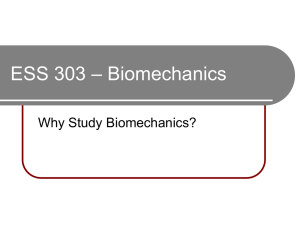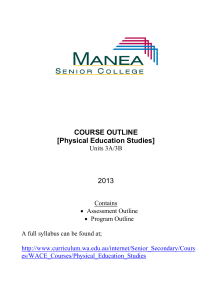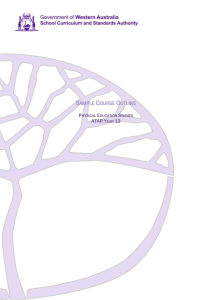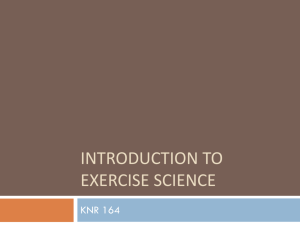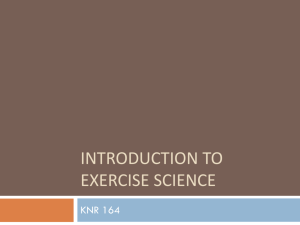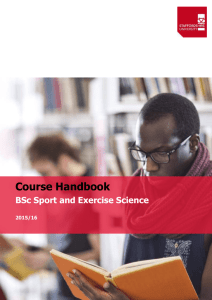File
advertisement
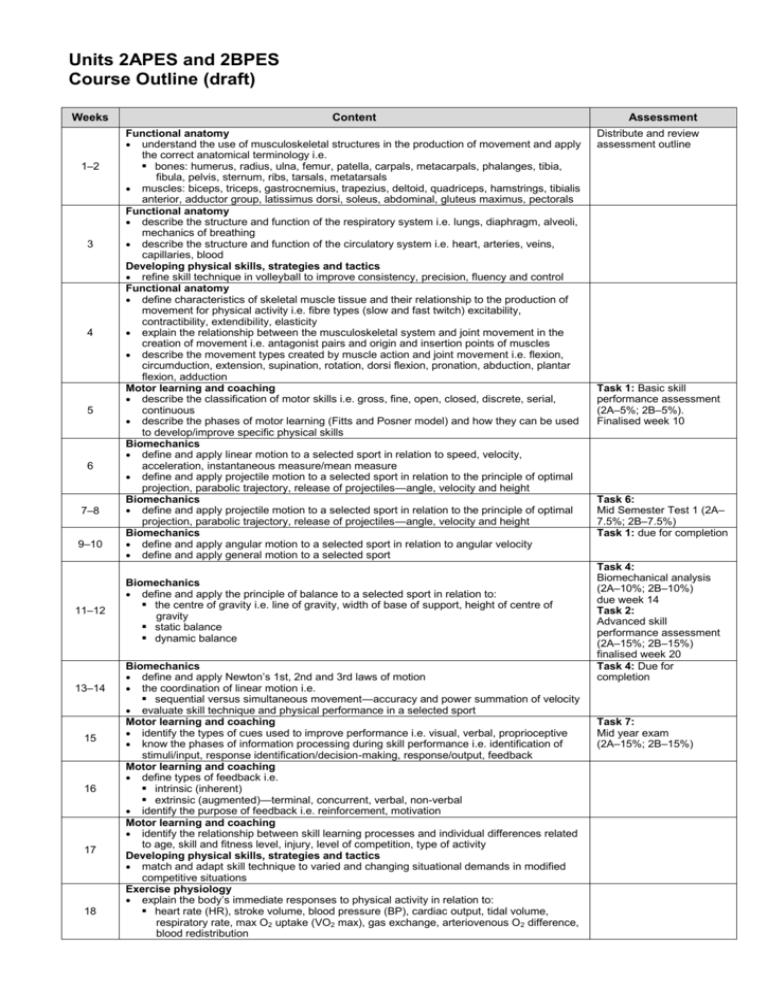
Units 2APES and 2BPES Course Outline (draft) Weeks 1–2 3 4 5 6 7–8 9–10 11–12 13–14 15 16 17 18 Content Functional anatomy understand the use of musculoskeletal structures in the production of movement and apply the correct anatomical terminology i.e. bones: humerus, radius, ulna, femur, patella, carpals, metacarpals, phalanges, tibia, fibula, pelvis, sternum, ribs, tarsals, metatarsals muscles: biceps, triceps, gastrocnemius, trapezius, deltoid, quadriceps, hamstrings, tibialis anterior, adductor group, latissimus dorsi, soleus, abdominal, gluteus maximus, pectorals Functional anatomy describe the structure and function of the respiratory system i.e. lungs, diaphragm, alveoli, mechanics of breathing describe the structure and function of the circulatory system i.e. heart, arteries, veins, capillaries, blood Developing physical skills, strategies and tactics refine skill technique in volleyball to improve consistency, precision, fluency and control Functional anatomy define characteristics of skeletal muscle tissue and their relationship to the production of movement for physical activity i.e. fibre types (slow and fast twitch) excitability, contractibility, extendibility, elasticity explain the relationship between the musculoskeletal system and joint movement in the creation of movement i.e. antagonist pairs and origin and insertion points of muscles describe the movement types created by muscle action and joint movement i.e. flexion, circumduction, extension, supination, rotation, dorsi flexion, pronation, abduction, plantar flexion, adduction Motor learning and coaching describe the classification of motor skills i.e. gross, fine, open, closed, discrete, serial, continuous describe the phases of motor learning (Fitts and Posner model) and how they can be used to develop/improve specific physical skills Biomechanics define and apply linear motion to a selected sport in relation to speed, velocity, acceleration, instantaneous measure/mean measure define and apply projectile motion to a selected sport in relation to the principle of optimal projection, parabolic trajectory, release of projectiles—angle, velocity and height Biomechanics define and apply projectile motion to a selected sport in relation to the principle of optimal projection, parabolic trajectory, release of projectiles—angle, velocity and height Biomechanics define and apply angular motion to a selected sport in relation to angular velocity define and apply general motion to a selected sport Biomechanics define and apply the principle of balance to a selected sport in relation to: the centre of gravity i.e. line of gravity, width of base of support, height of centre of gravity static balance dynamic balance Biomechanics define and apply Newton’s 1st, 2nd and 3rd laws of motion the coordination of linear motion i.e. sequential versus simultaneous movement—accuracy and power summation of velocity evaluate skill technique and physical performance in a selected sport Motor learning and coaching identify the types of cues used to improve performance i.e. visual, verbal, proprioceptive know the phases of information processing during skill performance i.e. identification of stimuli/input, response identification/decision-making, response/output, feedback Motor learning and coaching define types of feedback i.e. intrinsic (inherent) extrinsic (augmented)—terminal, concurrent, verbal, non-verbal identify the purpose of feedback i.e. reinforcement, motivation Motor learning and coaching identify the relationship between skill learning processes and individual differences related to age, skill and fitness level, injury, level of competition, type of activity Developing physical skills, strategies and tactics match and adapt skill technique to varied and changing situational demands in modified competitive situations Exercise physiology explain the body’s immediate responses to physical activity in relation to: heart rate (HR), stroke volume, blood pressure (BP), cardiac output, tidal volume, respiratory rate, max O2 uptake (VO2 max), gas exchange, arteriovenous O2 difference, blood redistribution Assessment Distribute and review assessment outline Task 1: Basic skill performance assessment (2A–5%; 2B–5%). Finalised week 10 Task 6: Mid Semester Test 1 (2A– 7.5%; 2B–7.5%) Task 1: due for completion Task 4: Biomechanical analysis (2A–10%; 2B–10%) due week 14 Task 2: Advanced skill performance assessment (2A–15%; 2B–15%) finalised week 20 Task 4: Due for completion Task 7: Mid year exam (2A–15%; 2B–15%) Weeks 19 20 21 22 23 24 25 26 27–29 30 Content Exercise physiology explain the body’s long-term adaptations to training in relation to cardiac output, heart rate (HR), blood pressure (BP), blood volume/haemoglobin, stroke volume, capillarisation, ventilation, O2 exchange, muscle hypertrophy, increased flexibility, increased aerobic and anaerobic capacity Exercise physiology explain the utilisation of carbohydrates, fats and proteins as energy sources for physical activity and their role in the onset of fatigue Exercise physiology describe the response of energy systems to physical activity i.e. anaerobic—ATP-CP (adenosine triphosphate–creatine phosphate) lactic acid aerobic Exercise physiology identify the relationship between energy systems and types of physical activity i.e. energy system continuum Developing physical skills, strategies and tactics identify tactical problems varying in complexity within a selected sport i.e. sport specific tactical framework select strategies to solve tactical problems in a selected sport implement solutions to solve tactical problems identified in modified competitive situations i.e. formations, width and depth of attack, deny space and delay in defence, respond to opposition Exercise physiology define training types i.e. resistance training—isometric, isotonic, isokinetic interval training continuous training circuit training fartlek flexibility plyometrics Exercise physiology explain the principles of training: specificity in relation to the nature of activity, positions and roles intensity duration frequency progressive overload reversibility explain the components of fitness i.e. cardiorespiratory endurance, muscular strength, muscular endurance, flexibility, body composition, agility, balance, coordination, reaction time, speed, power Exercise physiology explain the interrelationship between training types, fitness components and the principles of training Sports psychology understand the mental skills required for improving performance and achieving the ideal performance state (‘the zone’) i.e. intrinsic motivation self-confidence stress management concentration or attentional control— Nideffer’s model arousal regulation related to individual performance inverted U hypothesis Sports psychology understand the mental skills and strategies used to manage stress, motivation, concentration and arousal levels i.e. self-talk, self-imagery, relaxation evaluate the influence of age, skill level, and type of activity on mental skills in relation to motivation, arousal regulation (inverted U hypothesis), concentration evaluate and reassess personal goals according to changing situations i.e. age, skill level, type of activity Exam revision Assessment Task 5: Exercise Physiology (2A– 10%; 2B–10%) Due week 22 Task 2: due for completion Task 5: Due for completion Task 8: Mid semester test 2 (2A– 7.5%; 2B–7.5%) Task 3: Game performance assessment (2A–10%; 2B–10%) Finalised week 29 Task 3: due for completion Task 9: End of year exam (2A– 20%; 2B–20%)
